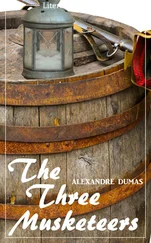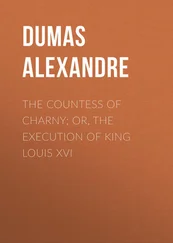“‘I’m afraid so,’ Adler agreed.
“‘They must think they’re dealing with foxes.’
“‘When they see our claws, they’ll know we are lions.’
“The more they advanced, the thicker the smoke rose, and the brighter grew the glow. They made the final turn. About fifty paces from the opening to the cave, a large fire, set more for its light than for smoke, was burning. In the light of the fire, they could see the dragoons’ guns and swords gleaming.
“‘And now we shall die,’ cried Montbar. ‘But first let us kill!’
“He was the first to leap into the circle of light, shooting from both barrels of his shotgun into the dragoons. Then, the emptied shotgun tossed aside, he pulled his pistols from his belt and, lowering his head, rushed toward the dragoons.”
“I won’t even try,” said the young count to Claire, “to tell you everything that happened then. It was a horrible battle, the swearing and cursing and shouting like the skies rumbling, the pistol shots like bolts of lightning. And when the pistols had been all discharged, they turned to the daggers.
“The gendarmes joined the battle, wielding their weapons in the dense, smoky red air, stumbling, falling, getting back up, falling once more. You could hear roars of rage and cries of agony. And sometimes a man’s last gasp.
“The killing lasted about a quarter of an hour, maybe twenty minutes. At the end, twenty-two bodies lay dead in the Ceyzériat caves. Thirteen of them were dragoons or gendarmes; nine were Companions of Jehu.
“Overwhelmed by numbers, only five Companions had survived. They had been taken alive, and Mademoiselle de Fargas regarded them as might the ancients’ Nemesis, while the gendarmes and dragoons, swords in hand, surrounded them.
“The old captain’s arm was broken, and the colonel had been shot in the thigh. Roland, covered with the blood of his opponents, had not sustained even a scratch.
“Torches were lit, and they all started back toward town. Two of the prisoners had to be carried on stretchers because they were unable to walk.
“As the weary procession was reaching the highway, a horse came galloping toward them. Roland stopped. ‘Keep moving,’ he said. ‘I’ll stay to see who this is.’
“When the horseman was about twenty paces away, Roland called out, ‘Who’s there?’
“‘One more prisoner, monsieur,’ the horseman answered. ‘I was not able to be present for the battle, so I insist on being present at the scaffold! Where are my friends?’
“‘Here, monsieur,’ said Roland.
“‘Please excuse me, monsieur,’ Morgan said. ‘I would like to claim my rightful place with my three friends, the Vicomte de Jahiat, the Comte de Valensolles, and the Marquis de Ribier.… I am the Comte Charles de Sainte-Hermine.’
“The three prisoners cried out in admiration. Diana cried out in joy. She now had all her prey; not one of the four leaders had escaped.
“The same night, according to the promise Roland had made to Diana and she to Cadoudal, the one hundred thousand francs from the Companions of Jehu left for Brittany.
“Now that the Companions of Jehu were in the hands of justice, Roland’s mission was completed. He came back to his post with the First Consul, then left for Brittany, where in vain he tried to persuade Cadoudal to join the Republican cause, returned to Paris, and accompanied the First Consul on his Italian campaign, in which he was killed at Marengo.
“As for Diana de Fargas, she was too caught up in her hatred and too thirsty for vengeance not to savor it until the bitter end. The trial would soon get under way, come to its conclusion, and end with a quadruple execution that she would most assuredly not miss.
“In Besançon I was alerted that my brother had been arrested, and I hurried to Bourg-en-Bresse where the jury would be meeting. The investigation began. There were six prisoners in all, the five who had been taken in the caves and the one who had joined them voluntarily. Two were so seriously wounded that within a week of their arrest they died from their injuries.
“At first the four remaining Companions were to be judged by a military tribunal and condemned to the firing squad, but the law intervened, declaring that political crimes would now be tried by civil courts. Thus the sentence would be the scaffold. The guillotine is ignominious; the firing squad is not. In a military court, the prisoners would have admitted everything; in the civil court, they denied all.
“Arrested under the names d’Assas, Adler, Montbar, and Morgan, they declared that they did not recognize those names. They said they were: Louis-André de Jahiat, born in Bâgé-le-Châtel in the Ain, twenty-seven years of age; Raoul-Frédéric-Auguste de Valensolles, born in Sainte-Colombe in the Rhône, twenty-nine years of age; Pierre-Auguste de Ribier, born in Bollène in the Vaucluse, twenty-six years of age; and Charles de Sainte-Hermine, born in Besançon in the Doubs, twenty-four years of age.”
XVIII Charles de Sainte-Hermine [2]
“THE PRISONERS ADMITTED they belonged to a group that had joined Monsieur de Teyssonnet, who was gathering an army in the Auvergne mountains. But they categorically denied that they had ever had the slightest connection with the stagecoach thieves named d’Assas, Adler, Montbar, and Morgan. They could make such brazen declarations because the stagecoaches had always been robbed by masked men. In only one case had the face of one of the leaders ever been seen, and that was my brother’s face.
“When they attacked the stagecoach running between Lyon and Vienne, a boy of about ten or twelve, who was in the cabriolet with the coachman, picked up the coachman’s pistol and shot at the Companions of Jehu. But the coachman, having foreseen just such a situation, had been careful not to load any bullets in his pistols. The boy’s mother, unaware of the coachman’s precaution, was so afraid for her son that she had fainted. My brother immediately tried to help her—he gave her some salts to breathe and tried to calm her shaken nerves—but as she thrashed about, she inadvertently knocked off Morgan’s mask and had been able to see Sainte-Hermine’s face.
“Throughout the trial, the public had great sympathy for the accused men. Each man’s alibi was proven by letters and witnesses, and the woman who had seen the bandit Morgan’s face declared that he was not among the four accused men. Furthermore, nobody had been harmed by their attacks, and nothing was taken but the treasure, and no one cared much about the treasure since there was no way of knowing who it belonged to really.
“The four men were about to be acquitted, when the president, turning unexpectedly to the woman who had fainted, asked, ‘Madame, would you be so good as to tell the court which of these gentlemen was gallant enough to provide the help you needed when you felt faint?’ The woman, caught unawares by the question, perhaps thought that while she was absent the four accused had admitted who they were. Or maybe she thought it a ploy to attract more sympathy for the accused men. Whatever she thought, she pointed to my brother and said, ‘Monsieur le Président, it was Monsieur le Comte de Sainte-Hermine.’
“Thus, the four accused men, all of them protected by the same indivisible alibi, were all of them brought down together and delivered to the hand of the executioner. ‘By Jove, Capitaine ,’ said de Jahiat, stressing the word ‘captain,’ ‘that will teach you what being gallant is all about.’
“One cry of joy arose in the courtroom. Diana de Fargas was triumphant.
“‘Madame’—my brother bowed to the woman who had identified him—‘you have just caused four heads to fall with one single blow.’ Realizing what she had done, the woman fell to her knees and begged for forgiveness. But it was too late!
Читать дальше












